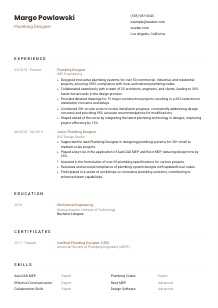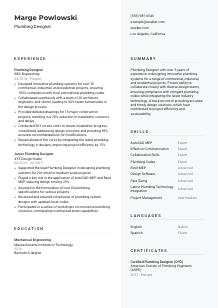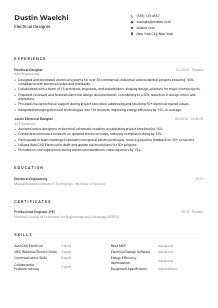Plumbing Designer Resume Example
Navigating pipe paths, but your resume is clogging up? Dive into this Plumbing Designer resume example, tailored with Wozber free resume builder. See how you can lay out your plumbing prowess to align with job specifications, fitting all the right pieces together in your career pipeline!

How to write a Plumbing Designer Resume?
Hello, aspiring Plumbing Designer! When it comes to plumbing design, it's not just about understanding pipe sizes and fixture placements; it's about translating technical skills into a document that passes through the tight sieve of Applicant Tracking Systems (ATS) and catches the eye of hiring managers. This tailored guide, leveraging Wozber's free resume builder, will navigate you through creating an ATS-compliant resume that doesn't just flow well but effectively showcases your expertise in plumbing design. Let's dive deep into the pipes of resume building and emerge victorious!
Personal Details
Just as a well-planned plumbing system begins with a blueprint, your resume starts with your personal details. It's more than just a formality; it's your digital handshake. Here's how to make every drop count.
1. Spotlight Your Name
Your name is the brand of your professional self. Think of it as the main valve; it must stand out. Employ a clear, professional font, making it slightly larger to draw immediate attention.
2. Clearly State Your Target Job Title
Directly below your name, anchor your desired position, "Plumbing Designer." This tactic is like marking a main water line; it makes your career intentions crystal clear to the hiring manager from the get-go.
3. Ensure Your Contact Details Flow
Like ensuring no leaks in a pipe joint, double-check your contact information for accuracy. Your phone number and a professional email (preferably firstname.lastname@email.com) are crucial. It's like laying down the pipes correctly the first time; it prevents future issues.
4. Location, Location, Location
"Must be located in Los Angeles, California." If you match this exact requirement, make it known in your resume. This piece of information is like to ensuring correct water pressure; it assures the employer you're right where they need you to be, with no relocation necessary.
5. A Professional URL or Portfolio
Adding a LinkedIn profile or a personal website is like installing a state-of-the-art fixture. It enhances your profile's functionality and accessibility, making sure recruiters can dive deeper into your professional world with ease.
Takeaway
Your contact section is the first pipe laid — make it secure, leak-proof, and straight to the point. With this foundation, you ensure the rest of your resume flows smoothly, leading you closer to your target role.





Experience
In the plumbing design world, your experience is your portfolio of successful projects. Let's map out how to showcase your professional journey effectively, making it as compelling as a well-installed plumbing system.
- Designed innovative plumbing systems for over 50 commercial, industrial, and residential projects, ensuring 100% compliance with local and national plumbing codes.
- Collaborated seamlessly with a team of 20 architects, engineers, and clients, leading to 30% faster turnarounds in the design process.
- Provided detailed drawings for 15 major construction projects, resulting in a 20% reduction in installation concerns and delays.
- Conducted 30+ on‑site visits to review installation progress, consistently addressing design concerns and providing 95% accurate recommendations for modifications.
- Stayed ahead of the curve by integrating the latest plumbing technology in designs, improving project efficiency by 15%.
- Supported the lead Plumbing Designer in designing plumbing systems for 20+ small to medium‑scale projects.
- Played a key role in the application of AutoCAD MEP and Revit MEP, reducing design time by 25%.
- Assisted in the formulation of over 60 plumbing specifications for various projects.
- Reviewed and ensured compliance of plumbing system designs with updated local codes.
- Participated in a series of workshops on innovative plumbing solutions, contributing to enhanced team capabilities.
1. Understand the Blueprint
Begin by dissecting the job description. For a Plumbing Designer, understanding requirements like "minimum of 3 years of experience" and "proficiency in AutoCAD MEP and Revit MEP" is crucial. It's like reading a plumbing plan; know what you need before you start the work.
2. Structure Matters
Organize your experience section like a neatly laid-out piping system - easy to follow and logically placed. Start with your most recent position, including your job title, company name, and dates of employment. This order helps the hiring manager navigate your professional history with ease.
3. Detail Your Achievements
"Designed innovative plumbing systems for over 50 commercial, industrial, and residential projects, ensuring 100% compliance with local and national plumbing codes." Using achievement-focused language shows the impact of your work, similar to how a blueprint shows the impact of a plumbing system on a building.
4. Quantify Your Impact
Adding numbers to your achievements, like "Collaborated seamlessly with a team of 20 architects," helps quantify your contributions. It's like specifying pipe sizes; it gives a clear picture of what you handle and the scale of your work.
5. Relevancy is Key
Ensure every listed experience is relevant to the job you're applying for. Unrelated accomplishments, while impressive, may divert attention away from your suitability for the role, much like a poorly placed vent can disrupt a plumbing system's flow.
Takeaway
Your experience section is now as impressive as a masterfully executed piping layout. By effectively showcasing your history, you've confidently communicated your ability to handle the challenges of a Plumbing Designer role.
Education
In plumbing design, your education is the foundation upon which your skills are built. Let's ensure your educational background aligns seamlessly with the job requirements, showcasing your qualifications with precision.
1. Highlight the Required Degree
The job calls for a "Bachelor's degree in Mechanical Engineering or a related field." Make sure your degree is front and center. This acts like having the right wrench for the job; it's essential for the task at hand.
2. Structure with Clarity
List your degree, the field of study, institution name, and graduation date in a clear, concise manner. It's akin to labeling pipes in a system; it makes it easy for anyone to understand at a glance.
3. Match Your Degree to the Job
If your degree directly aligns with the job requirement, such as "Bachelor's degree in Mechanical Engineering," it's like the perfect pipe fit; it shows you have the exact foundation they're looking for.
4. Relevant Courses and Projects
Consider mentioning any highly relevant courses or projects, especially if they directly relate to plumbing design. This can add depth to your educational background, similar to how a well-designed sump adds functionality to a drainage system.
5. Additional Achievements
Graduating with honors or completing significant projects in plumbing design are worth mentioning. These additional accolades act like premium fixtures in a plumbing system; they improve the overall value and functionality.
Takeaway
Your education section now solidly supports your career ambitions, laying a strong foundation much like a robust underfloor heating system provides comfort and reliability.
Certificates
In the competitive realm of plumbing design, certifications can provide you with an edge, acting as proof of your commitment and expertise. It's time to put those accolades front and center, ensuring they shine bright.
1. Job Requirements Alignment
With requirements such as "Certification in plumbing design or Professional Engineer (PE) license," it's clear what the job values. Align your certifications with these preferences. Think of it as picking the right tool for the job; it makes all the difference.
2. Quality Over Quantity
List the most relevant certifications first, such as the "Certified Plumbing Designer (CPD)". This ensures the hiring manager sees the most pertinent qualifications at a glance — akin to highlighting the main shutoff valve in a schematic.
3. Dates Matter
If applicable, include the acquisition or expiration dates of your certifications. This information, while sometimes overlooked, is like specifying the warranty period for a plumbing installation; it adds credibility and trust.
4. Continuous Improvement
Highlight any recent or ongoing certification courses, especially those in cutting-edge plumbing technologies or design software. This shows your commitment to staying at the forefront of the industry, much like the continuous updating of building codes ensures safety and efficiency.
Takeaway
Your certificates section now thoroughly showcases your dedication to professional growth and adherence to industry standards, positioning you as a leading candidate for the Plumbing Designer role.
Skills
A Plumbing Designer's toolbox must be filled with both technical and soft skills. Let's curate a skillset that not only matches the job description but also sets you apart from the competition.
1. Decipher the Job's Skillset
Extract essential skills from the job description, such as proficiency in "AutoCAD MEP and Revit MEP," an "understanding of plumbing codes," and "effective communication." This process is like fitting the correct gauge pipe for the required flow rate; it ensures efficiency and compliance.
2. Tailor Your List
Prioritize the skills that match the job's requirements, focusing on those where you excel. This selective listing is akin to choosing the right fittings for a complex pipe network; it ensures a perfect connection every time.
3. Presentation is Key
Arrange your skills in a logical, easy-to-read manner. This organization makes it straightforward for the hiring manager to see your qualifications, similar to how a well-labeled control panel simplifies system management.
Takeaway
Your skills section is now a testament to your capabilities, designed to withstand the scrutiny of ATS and impress hiring managers, mirroring the reliability and efficiency of a well-designed plumbing system.
Languages
In today's global job market, being multilingual can set you apart. For a Plumbing Designer, clear communication is as crucial as ensuring water flows correctly through pipes. Let's ensure your language skills reflect your ability to connect with diverse teams.
1. Job Description Insight
The job specifically requires "Proficiency in English language for professional communication." This requirement should take precedence in your languages section, ensuring it's the first language listed. It's equivalent to the main water supply line; it's fundamental.
2. Prioritize and List
List English as 'Native' or 'Fluent,' followed by any additional languages you speak. This structure, akin to organizing pipes by size and function, ensures clarity and functionality.
3. Detail Your Fluency
Clearly define your proficiency levels, using terms like 'Native,' 'Fluent,' 'Intermediate,' or 'Basic.' This clarity is akin to specifying pipe diameters and materials; it leaves no room for misinterpretation.
4. Additional Languages
If you know languages beyond the job's requirements, list them. Each additional language is like an auxiliary water line; not always necessary, but potentially very useful.
5. The Global Marketplace
Consider how each language you speak can benefit your role, especially in a city as diverse as Los Angeles. This global perspective is like understanding international plumbing codes; it enhances your versatility and appeal.
Takeaway
With your language skills effectively showcased, you've added another layer of value to your candidature, broadening your communicative reach just as a versatile plumbing system caters to various functions within a building.
Summary
A powerful summary is a concentrated dose of your professional capabilities. Let's distill your experiences, skills, and qualities into a compelling narrative that captures the essence of your candidacy for the Plumbing Designer role.
1. Grasp the Core of the Role
Begin by fully understanding what the job entails and what the employer values. This step is like assessing water pressure needs before designing; it informs your strategy.
2. Concise Introduction
Start your summary with a clear, potent statement about your profession and experience. Think of this as the main shut-off valve; it's what everything else depends on.
3. Reflect on Key Job Requirements
Mention your relevant skills and notable achievements, especially those aligning with the job description. It's like selecting the right pipe material for each application; it makes your resume more effective and durable.
4. Brevity is Your Friend
Keep your summary succinct, aiming for 3-5 impactful lines that convey your value. It's akin to minimizing water runs in a plumbing system; it maximizes efficiency and minimizes waste.
Takeaway
Your summary now encapsulates your professional identity, distilled into a compelling narrative that flows as smoothly as water through well-designed plumbing. It leaves hiring managers eager to learn more about you, the astute Plumbing Designer before them.
Embarking on Your Plumbing Design Career Path
Congratulations! You've navigated the complexities of crafting a tailored, ATS-compliant resume. With Wozber's free resume builder, ATS-friendly resume templates, and ATS resume scanner at your disposal, you're well-equipped to create a resume that not only passes through ATS filters but also resonates with hiring managers. Your journey as a Plumbing Designer is poised for its next major milestone.
Remember, this resume is the blueprint for your career success. Refine it, present it with confidence, and prepare to make your mark in the world of plumbing design.

- Bachelor's degree in Mechanical Engineering or a related field.
- Minimum of 3 years of experience in plumbing system design or related field.
- Proficiency in design software such as AutoCAD MEP and Revit MEP.
- Strong understanding of local and national plumbing codes and standards.
- Effective communication and collaboration skills with clients, architects, and design teams.
- Certification in plumbing design or Professional Engineer (PE) license, where applicable.
- Proficiency in English language for professional communication is essential.
- Must be located in Los Angeles, California.
- Design plumbing systems for commercial, industrial, and residential projects ensuring compliance with codes, regulations, and specific project requirements.
- Collaborate with architects, engineers, and clients throughout the design process to ensure the plumbing system meets user needs.
- Provide detailed drawings and specifications for construction projects, including pipe sizing, fixture selection, and equipment placement.
- Conduct on-site visits to review installation progress, address design concerns, and provide recommendations for modifications if necessary.
- Stay updated with the latest plumbing technology, best practices, and industry trends to ensure designs remain innovative and efficient.















